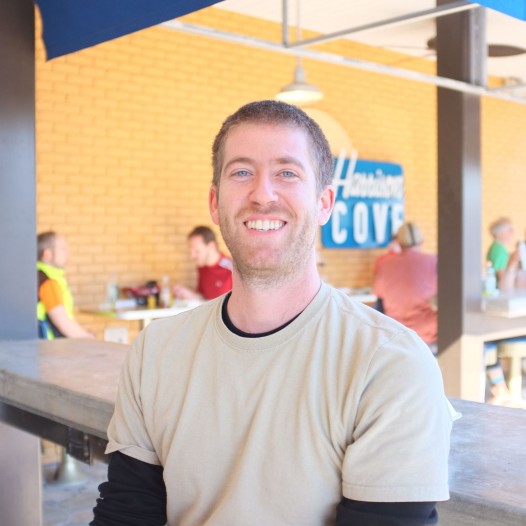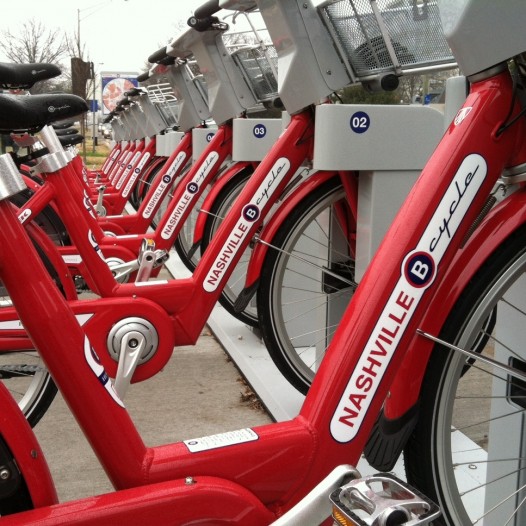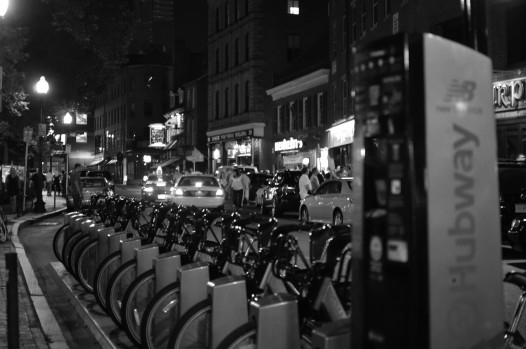Recently I caught up with J.J. Smith and Jamie Wine, Bicycle Valet Coordinator and Executive Director of Bike Easy respectively, about the upcoming Bike Valet and B-Cycle Bike Share Demonstration that will be front and center throughout the Super Bowl festivities to be held downtown near the Convention Center this week and into the weekend.
We covered many topics, ranging from how each got involved with Bike Easy and how far the organization has come in the last few years to how the programs got hooked up with the Super Bowl, the significance of each, and specifics for the weekend.
Below is “Part One” of each interview, containing excerpts related to the latter aspects of the program as listed above – the “need to know information” for how (and why) to take advantage of these programs during the next few days.
First up was J.J. on the subject Bike Valet for the weekend:

J.J. Smith took time out of his busy League of American Cyclist training to share about the Super Bowl Bicycle Valet. Photo by M.T. Hinson
M.T.: Ok, so, Bike Easy is doing Bike Valet at the Super Bowl?
J.J.: Yes.
M.T.: Yes.
Laughter
M.T.: We can edit out all the laughter.
So, what is it that you do with Bike Easy in terms of the Bike Valet? What is the Bike Valet? Why does the Super Bowl want it?
J.J.: Well Bike Valet is like coat check for bikes.
I’ll back track a little bit.
My official title with Bike Easy is Bicycle Valet Coordinator. So, it’s my job to deal with the events: getting everything organized as far as the site were going to be at, potential media attention, and working with the event – communicating clearly to them what we need them to do and what we are going to provide as our service.
So, Bike Valet is like coat check for bikes. It is monitored bike parking at events and it’s free to the public. Somebody rides their bike up. We take it from them. We mark it with their information and give them a tag. They come back with their tag and they claim their bike. It’s safe and secure. It is monitored the entire time.
M.T.: So how did Bike Valet get involved with the Super Bowl?
J.J.: We work with different people on the host committee. One of our sponsors, Entergy, has sponsored a lot of the work we’ve done. They’ve been a great partner for different events, for the Bicycle Second Lines, for the Bike to Work Day last year. And, one of our colleagues at Entergy is on the host committee.
M.T.: That’s great. So what are some of the specifics? Where is Bike Valet going to be set up with the Super Bowl?
J.J.: Well the exact location is actually yet to be determined. It’s kind of that close to the wire of a thing. But it’s probably going to be at the old Gap in the mall at the Riverwalk Marketplace.
(Editor’s note: It has since been confirmed that the Super Bowl Bicycle Valet will, in fact, be located outside of the former Gap in the Riverwalk shopping center. For more information as well as a map depicting the locations of each event, check out Super Bowl Bicycle Valet‘s event page.)
It’s important because it makes it that much easier for people to bike and feel safe about leaving their bike somewhere.
You know. You go downtown. You can’t find a parking spot. It’s even harder to find a secure parking spot. And when you do, you know, your bike is in the way.
There’re going to be so many people downtown at that time that a bike locked up to a sign post creates congestion on the street. There’s a real lack of suitable “end of trip facilities” (bike racks) in the CBD and the French Quarter. And, your bike’s not safe when it’s on the street. Anybody could mess with it. It could easily get stolen. With Bike Valet, you don’t have to worry about it. You ride your bike knowing that you will be able to leave it somewhere safe — that it will be there when it’s time for you to go home.
And that’s one of the main goals of Bike Easy — to make it as easy, safe, and fun to bike as possible.
So bike valet is a great way for us to offer a service that directly impacts people’s riding experience.
M.T.: That really is great. When will it be going on? How long is going to be offered? Do y’all still need volunteers?
J.J.: We do still need volunteers. We could use volunteers for every shift at this point.
It will be every day from Wednesday, Jan. 30, through Sunday, Super Bowl Sunday, Feb. 3.
We’re offering the service from 10 a.m. to 10 p.m. And, there are two shifts available. Each day the first shift is 10 a.m. to 4 p.m. and then from 4 p.m. to 10 p.m.
M.T.: And, if anyone wants to volunteer, how can they get hooked up with you?
J.J.: They should email me. It’s jj@bikeeasy.org.
Next, Jamie went into detail about the huge news for the city’s cyclers: the B-Cycle Bike-Share demonstration that will be in place Wednesday, Jan. 30th through Super Bowl Sunday, Feb. 3:

Nashville B-Cycle kiosk at Hillsboro Village. Nashville has a bike share program. Why doesn’t New Orleans? Photo by M.T. Hinson
M.T.: So, we’ve got a bike share demo coming to the Super Bowl? That’s kind of a big deal.
J.W.: Yeah. I mean Bike Easy’s kind of a big deal. Bike share’s kind of a big deal. Makes sense that we would, you know…
M.T.: Right. Right. Right.
J.W.: …Super Bowl’s also kind of a big deal.
M.T.: So, for the demonstration and the Super Bowl, do you know where the stations might be set up? How is it going to work for people who are here during the Super Bowl?
J.W.: Entergy is funding the bicycle share and they put up their own money. They’ve already put up over $400,000 in funding infrastructure in the city.
So, this is the next step. They want more people on bicycles. They want more visibility for bicyclists. And they realize the health, and the economic, and the environmental benefits of bicycling. They want to help promote that. They helped us pay B-cycle, the vendor who is coming in, to bring 20 bikes — 10 bikes at each location and two kiosks.
The kiosks are going to be at Julia and Convention Center Boulevard. Right there where the Riverwalk and the Convention Center entrances are on the sidewalk is where one station is going to be. Then the second station is supposedly going to be in Woldenberg Park or next to the World Trade Center. So the second station is not 100 percent yet. But it’s going to be over there.
(Editor’s note: It has since been confirmed that the second Super Bowl Bicycle Share kiosk will be located outside of the World Trade Center near the Riverwalk Spanish Plaza. For more information as well as a map depicting the locations of each event, check out Super Bowl Bicycle Share‘s event page.)
So — we’re still figuring out the logistics — you’ll be able to check out a bike from a bike share kiosk at one location, bicycle over, and check it back in at the other location. That’s why they wanted to do two. Entergy really wanted to have people try it out where they check it out at the station and then check it back in and see what it feels like.
M.T.: Emphasize the point-to-point nature of it — keeping bikes in circulation?
J.W.: What we really want to avoid is people going and tooling around for five hours and not bringing our bike back. So we’re going to incentivize that, probably financially. It’s free to use. But you’ve got to put some sort of deposit down. So you’re not just riding off into the sunset with a $1200 bike.

Boston Hubway kiosk at the foot of Union Street. For some reason, Boston refers to itself as the “Hub of the Universe”. Talk amongst yourselves… Photo by M.T. Hinson
M.T.: Sweet. Well, that is awesome.
J.W.: Yeah we’re really excited about it.
The next step will be to actually have a bike share system in the city.
It’s in our feasibility study. People can read it on bikeeasy.org.
A real system in New Orleans is actually relatively small. It would cost $1.5 million for the first three years. Which is what you generally invest for. Three years and then it breaks even.
The system would be about 200 bikes — about 20 kiosks. It would be mostly in the downtown core and a little bit into the surrounding neighborhoods at first.
Then, after it started making revenue, then it would expand radially into the neighborhood.
Or, we could have a couple satellite stations that were sponsored at Tulane, or maybe Sojourner Truth Community Center, or at City Park. You would have destinations people would be going to from downtown. They could check out a bike. Ride out there. Check it back in. Check out the location. Then, do the same thing on the way back.
M.T.: That’s the whole point, isn’t it?
J.W.: Mmmhmm. So, 200 bikes. 20 stations. $1.5 million. And, due to the feds, all we need is $300,000 locally. So I think it’s totally doable. It’s a very exciting project for the city — for economic, social, and environmental reasons.
Stay tuned for “Part Two” of the interviews, when J.J. and Jamie go into some of the history leading up to each of these benchmark events, as well as photos of the action downtown.
M.T. Hinson writes about the cycling community for NolaVie.
 New Orleans Startups
A brief overview of the growing New Orleans startup scene. This piece highlights the main industries of New Orleans, competing cities, and just how emerging the current entrepreneurial/startup scene is in New Orleans.
New Orleans Startups
A brief overview of the growing New Orleans startup scene. This piece highlights the main industries of New Orleans, competing cities, and just how emerging the current entrepreneurial/startup scene is in New Orleans.
 A Bin in Every Classroom: Why Tulane Should Lead on Composting
I asked a peer, Isabel, for her thoughts on composting: “Why do...
Tulane
A Bin in Every Classroom: Why Tulane Should Lead on Composting
I asked a peer, Isabel, for her thoughts on composting: “Why do...
Tulane